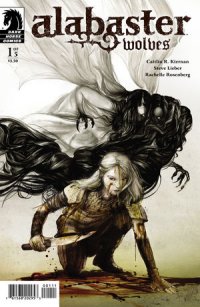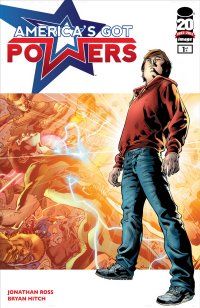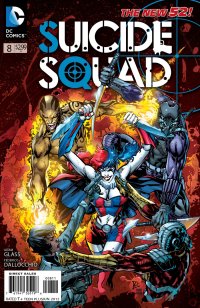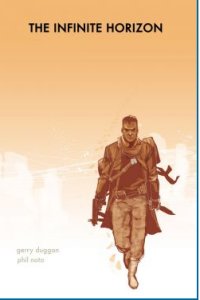Secret #1 (Image, $3.50)
by Graig Kent
There’s very few comics creators out there that have a perfect track record with me. Some of my favorites like Rucka, Brubaker and Vaughan, even monolithic names like Gaiman, Moore and Morrison have produced plenty of works I don’t like or even care to try and read. Obviously the longer a creator is in the business, and the more work they produce, the more likely they are to fail at some point. Jonathan Hickman made a huge impact with The Nightly News over half a decade ago, and project after project — from his creator-owned works like Pax Romana and The Red Wing to his prolific Marvel work like Fantastic Four and Secret Warriors — Hickman has yet to disappoint me. Sure, some of his work I may like more than others, but I’m a fairly loyal follower, and nothing he’s written so far has failed to strike my interest or let me down. Ultimately, what I’m saying is he’s due for a failure.
Thankfully, Secret isn’t it.
Hickman’s repertoire is a fairly consistent mix of conspiracy, espionage, extreme science, and superhero genres, usually a melding of two or more, and always high-concept. With this in mind, Secret is a fairly straightforward, abandoning most higher genre ideas, heading more into straight-up conspiracy thriller territory. The setting (so far) seems more real-world than your average Hickman book, though delving into the lives of the one-percent, the uber-rich who live lives generally separated from the masses, using their vast resources to cushion themselves from any potential offense. The book starts with a Washington accountant having his home defenses shattered. Sitting naked and tied to a chair, a tooth is extracted with pliers just to underscore the seriousness of his assailant. The rest of his encounter is relayed to his lawyer, a partner in a high powered firm with close ties to a third-party security agency, one they trust with every secret because, well, they’ve discovered them all already.
There’s a game at play in Secret, but what it is hasn’t been fully revealed just yet. Astute readers will start picking up on it about halfway through this first issue, the rest will catch up by the revelation at end. I can see some people having difficulty investing in Secret, since, as of yet, there’s not an obvious central figure, nor is it obvious if it’s even an ensemble book. However it is a well crafted introduction, and for what it lacks in defining characters, it makes up for in intrigue. Hickman is skilled at serialized storytelling, and here it’s as much in the structure of the story as it is in the design of the book. A Hickman trademark, there’s a dramatic sense of design, starting with the stark black and white photographic cover of teeth and gums with tendrils of darkness creeping around it like a plague, and the second issue promises an equally enticing graphic cover of another body part.
Ryan Bodenheim was paired with Hickman on his most frustrating series, A Red Mass For Mars, which suffered not in story, but from serious timeliness issues (it took a full 2 years to release its four issues). Hopefully the duo can maintain a tighter schedule for Secret as it will suffer if it’s momentum isn’t maintained. Bodenheim, for his part, provides visuals that work on every level, complimenting and building the story. Bodenheim’s work may not be the most stylized, but it is exceptionally clean, keeping his lines tight and meaningful, like leaving the light and shadow to colorist Michael Garland who delivers with a fluctuating but vivid monochromatic palette. Bodenheim’s work is well detailed, in character and scene. His faces are distinct and well designed, expressive (but could be more so), and his page layouts are just as clean as the rest of his work, dealing as well with splash pages as with 16-panel grids. It’s definitely a favorable writer-artist pairing.
Where Hickman’s other creator-owned series which launched last month, Manhattan Projects, was a bit hindered by its high concept in the opening chapter, Secret is perfectly paced and more accessible. Not that it’s a competition, mind you.
Rating: 




Out of a Possible 5 Stars
 Alabaster: Wolves #1 (Dark Horse, $3.50)
Alabaster: Wolves #1 (Dark Horse, $3.50)
By D. S. Randlett
I had never heard of Dancy Flammarion, the main character in a series of prose stories by writer Caitlin Kiernan. But I’m a sucker for a Greg Ruth cover, and this one promised something cool. Dancy’s a not quite typical American teenager. There’s the fact that she’s an albino. And she’s a homeless person roaming the South. And she kills monsters at the behest of a multiheaded angel with bat wings that only she can see. Taking all of that into account, it would seem that she would fit right into the Dark Horse stable alongside Hellboy and Buffy.
Of course, Alabaster does fit in with the Dark Horse horror/adventure books, but there are some things that set this new series apart. For one, there’s the tone. Alabaster feels like serious business, and more like a straight up horror book than either Hellboy or Buffy. There is very little mixing here. There is no big Kirby-inspired action, or any witty barbs. This first issue plays like a Leone showdown. There’s a lot of staring, talking, and introspection followed by an explosion of violence that’s over as soon as it began.
As an introduction to this character, however, this first issue doesn’t have much to offer. Kiernan wants to introduce new readers to her creation, without rehashing Dancy’s story for old fans. She doesn’t quite manage that balance. It doesn’t sink the book by any means, but I was left wondering a few things. Chiefly, why is Dancy homeless? There’s obviously a story there, and it feels like something that would be essential to knowing who this character is.
Still, Kiernan is a pretty gifted writer, and she manages to draw the reader into her story even though the main character is a little too enigmatic. The story starts quietly enough, but the tension ratchets up quickly. I mentioned the similarity to a Leone showdown, but the story also has the qualities of a dark fable full of riddles and nocturnal hunger. The art by Steve Lieber is up to the task of capturing this story. It calls to mind the Vertigo horror style from the late 80s and early 90s, and evokes a real sense of mood and does a great job of capturing the story’s more gruesome moments.
Alabaster: Wolves is a series worth checking out if you’re willing to deal with some minor barriers to entry. If you like Moorcock’s Elric stories (an obvious touchstone) or some of the better Hellblazer runs, give this one a shot.
Rating: 




Out of a Possible 5 Stars
America’s Got Powers #1 of 6 (Image, $2.99)
By Jeb D.
Celebrities turned comic book writers has been something of a trend recently, and while the typical such project involves an actor coming up with an idea they think would be perfect for the comics, then having a professional writer collaborate or ghost the actual script, one impressive exception was British TV personality Jonathan Ross. Unlike, say, Rosario Dawson or Tyrese, Ross brought to the table not only a love of comics, but a strong working knowledge of their history–and, more important, an understanding of how, when, and why they work, demonstrated amply in his TV series Comics Britannia, and his fascinating documentary film, In Search of Steve Ditko. So when Ross and Tommy Lee Edwards launched Turf a couple years ago, it was more highly anticipated than your usual celeb vanity project, and the result was… well, certainly promising. A Depression-era story of gangsters, vampires, and aliens, it had the overstuffed quality of a creative, geeky, mind unburdening itself of a lifetime’s worth of “cool stuff”; it also suffered from something to which both new comic writers, and anyone who makes his living with words, are prone: it was so heavy with expositional dialog that the characters were sometimes ducking down to avoid bumping into all the text boxes and word balloons, causing the pacing to slog when it should quicken the pulse, and making the overall effect more interesting than involving.
For his second comic outing, Ross shows real growth in that area: he’s tightened up the dialog, and learned how to let his artist (in this case, Mr Widescreen himself, Bryan Hitch) handle a lot of the exposition. Problem is, the genesis of this story isn’t fantastic flights of geeky imagination, but a riff on as tired a modern trope as I can imagine (short of zombies): “reality”-based TV talent contests.
In a near-future San Francisco (nicely done, Mr. Hitch-going to trash the building I work in before we’re through?), the appearance of a mysterious crystal recently gave superpowers to all the in utero children in a five-mile radius at the time. A few years later, these super-adolescents now fight for the chance to join the only government-sanctioned superteam (oh, and for TV ratings), duking it out on a show called “America’s Got Powers.” Our windows on this world take the form of our protagonist, Tommy Watts, who (wouldn’t you know it) seems to be the only kid who didn’t get any powers during The Event, and whose brother died in his “America’s Got Powers” appearance; and one Professor Syell, the creator of “AGP.” There’s plenty of backbiting among the contestants, and corporate and political double-dealing behind the scenes, in this issue, with promise of much more to come. The “Hero’s Journey” and “Battle Royale/Hunger Games” stuff that are laid out in this issue suggest a pretty straightforward, not to say predictable, story to come, so here’s hoping that Ross has a few twists up his sleeve in future issues.
Bryan Hitch is a divisive artist, and he hits it right down the middle here. Those who love his uber-detailed action epics can wallow in the brutal fight scenes (and his lovely City By The Bay travelogue); those who find his celebrity casting distracting and/or irritating will bemoan the plethora of familiar faces, from David Tennant to Sarah Palin, that populate this world, “playing” various characters.
No question, this is an impressively capable first issue, with Ross turning in as professional a job as Hitch and his team of inkers, Andrew Currie and Paul Neary, and colorist Paul Mounts, and the full 32 pages of story for $2.99 is appreciated. Given my druthers, I’d trade a pound of professionalism for an ounce or two more of inspiration, but I’m in, at least for one more issue.
Rating: 




Out of a Possible 5 Stars
 Suicide Squad #8 (DC, $2.99)
Suicide Squad #8 (DC, $2.99)
by Graig Kent
This book shouldn’t appeal to me. It’s crass, it’s excessive, it lacks anything resembling subtlety, it’s egregiously violent, and for DC purists, just outright offensive in its rebooted revisions of certain characters. It earns its hard “T+” rating (you know, those bolded words underneath the UPC code everyone ignores) by trying to shock its readers with its ruthlessness, leaving nothing except Harley Quinn’s nipples to the imagination.
The “New 52” Amanda Waller is younger, leaner, and leggier. Harley Quinn loses her quirky, innocent charm in a tawdry bodice and hot pants and a psychopathic attitude rivaling the Joker. All the character building Gail Simone did with Deadshot has been tossed out the window as he’s back to being a guy who just likes to shoot things. Unlike the Suicide Squad of old, there’s no low-key to this team (hard to be low-key when you have a man-shark wandering around) and the focus of the series seems to be more on how expendable the characters are than who the characters are.
Even still, I do so enjoy this book. No, it’s not gentle and it openly challenges the status quo of the Squad of old, but if you can get your head out of the past, you can find plenty to enjoy in this gnarled and twisted, bleak and blackly humorous book.
I think Adam Glass is getting a bad rap for his work from fans and critics who want him to be John Ostrander or Gail Simone. He doesn’t have Ostrander’s penchant for densely structured storytelling or Simone’s gift of sharp dialogue, but he does honestly have a sense of who the characters are that he’s working with, and his style is more sadistically fun than grim. Unlike, say, a Mark Millar, Glass provides an action-heavy, violent, and grim look at the world of super-beings that doesn’t pretend to be anything other than what it is, nor does he ever overreach. But Glass is also given a unique (perhaps dangerous) opportunity few other writers in the New 52 have. With access to the bulk of DC’s unused supervillain roster, he can expand the history of new DC Universe rapidly, and simply with only a few lines of dialogue discussing past encounters with heroes, villains and organizations around the globe.
This issue finds the Squad experiencing their first moment of downtime. For the first time in the series the new Amanda Waller steps into the forefront, and guess what, she’s just as all-balls as she was before. She may have nicer gams and a prettier mug, but this is still a hard, hard woman. We get a moment with each member of the Squad — Harley, El Diablo, Black Spider, King Shark, Lime Light, Deadshot, and a departing Savant — each providing just a little more insight into their character, their relationship with Waller, and/or their role on the team. Strewn throughout is a series of flashbacks inferring that there’s a traitor on the team, which is a pretty low-stakes storyline to set up (given how murderous and backstabby these characters already are), yet no less entertaining.
This isn’t a book for lovers of the “art of comics”, There’s not a lot of “art” here. There is plenty of escapist brutality. This isn’t quite as lowest-common-denominator as some would have you believe, as there’s definitely a grindhouse-like craft to what Glass is doing here, but that is obviously something not everyone is going to like or respond well to, or think has a place in the DC Universe. Fair enough. I understand and respect that, but I’m going to keep reading and enjoying it for the sensationalistic B-movie action series it is.
Plus, I can’t wait to see if/how Yo-Yo escapes from King Sharks’ intestines.
Rating: 




Out of a Possible 5 Stars
The Infinite Horizon (Image, $17.99)
By D.S. Randlett
If you’re reading CHUD, you’ve probably complained about movie remakes at some point, and bemoaned this new trend. But the fact is that the remake has been with us forever in literature. Granted, literary remakes and reimaginings have taken every opportunity to be just as crass as the much bemoaned Hollywood remake can be. I’m thinking about all of those Jane Austen books with monsters inserted, and I won’t be surprised if I see a retelling of Moby Dick where the whale is a kraken and Ahab is a lightning mage. But cinema has its share of virtuous remakes (chewers are of course familiar with Carpenter’s The Thing), and there are works of literature that have retold older stories, commenting on and illuminating the originals while telling worthwhile stories in their own right.
The Odyssey is one of the most retold stories, and it has arguably only been equaled once by James Joyce. Most retellings of The Odyssey fail to grasp what the original is really about, and thus fail to understand why Homer’s second epic has stood on its own for so long. Reread the epic and ask people what The Odyssey is about. They will likely tell you that it’s about Odysseus’ attempts to reach his homeland, and recount episodes like the Lotus Eaters or the Cyclops. But those stories only take up half of the book. The rest of the book is about Odysseus’ homecoming, not only to Ithaca but to himself. It’s a story about a man reclaiming his humanity after a long, great war. All too often, artists working with the template of The Odyssey fail to grasp the totality of the original work, and they sell themselves short in the process.
The Odyssey, set in the near future. A nameless soldier is trying to get to his home in upstate New York that is likewise unnamed (Why not just admit that it’s Ithaca, New York?) from the Middle East. Unfortunately, global tensions have resulted in something of a societal collapse, so he can’t exactly hop on a plane.
On his quest home, the soldier experiences episodes that are echoes of episodes from the Odyssey. Some of these are cleverly handled and quite thrilling. While I think that this retelling misses the point of its source material, it’s a well written and well drawn read. The action scenes have a real sense of brutality and impact thanks to Phil Noto’s art, and Gerry Duggan’s script feels urgent and dramatic. Even though you know what’s going to happen, you’ll probably want to see what happens.
But still, the lack of real thematic content here is noticeable, and that makes it hard to really recommend this story wholeheartedly. If you’re looking for a well written and drawn yarn, this isn’t a bad place to look. But there’s a palpable sense of ambition here that the book doesn’t quite live up to, and that feels like a disappointment.
Rating: 




Out of a Possible 5 Stars